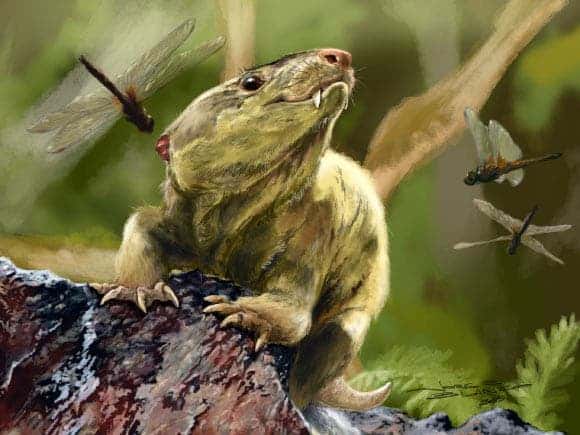Some 184 million years ago, an unfortunate synapsid hatchling had a horrible day. Through circumstances which aren’t exactly clear, the creature was killed before hatching, and the environmental conditions were just right to fossilize it. Not exactly a mammal but very mammal-like, this synapsid fossil could teach us a lot about how mammals developed their reproductive strategy.

As we learn during the early school years, mammals are defined by reproduction: almost all bear live young (rather than eggs) and they nurse them with milk. Unlike many other creatures, mammals don’t produce numerous offspring — instead, they invest heavily in few offspring.
This approach is also visible in the changes of the early skull development. Mammal heads, particularly those of young mammals, show distinct adaptations which accommodate bigger brains. Unfortunately, this is almost never present in the fossil record, because the young of both mammals and their forebears are so fragile they’re almost never preserved as fossils. But paleontologists got lucky.
[panel style=”panel-info” title=”Synapsids” footer=””]
Synapsids are a group of animals that includes mammals and any animals closely related to mammals — including their forebears. Early synapsids are regarded as mammal-like reptiles, although some are more likely to consider them proto-mammals. Whatever the name choice may be, they shared characteristics of both mammals and reptiles.
Synapsids were the largest terrestrial vertebrates in the Permian period, 299 to 251 million years ago. They had a bit of a rougher period during the Mesozoic when dinosaurs ruled as the dominating group. But after the Cretaceous (the end of the Mesozoic), the synapsids (in the form of mammals) again became the largest land animals.
[/panel]
The researchers discovered a clutch containing 38 young, belonging to a species called Kayentatherium wellesi — a synapsid. This is twice the number that you’d expect for any mammal but is exactly what you’d expect for a reptile. However, the young have skulls similar in shape to that of the adult. This suggests that the young hadn’t undergone the cranial lengthening seen in modern mammals.
“The find is among the rarest of the rare because it contains the only known fossils of babies from any mammal precursor,” said Eva Hoffman and Professor Timothy Rowe, lead authors from the Jackson School of Geosciences at the University of Texas at Austin. “But the presence of so many babies — more than twice the average litter size of any living mammal — revealed that it reproduced in a manner akin to reptiles.”
This helps researchers develop a more accurate timeline for those biological developments — aside from providing a unique find. Because direct fossil evidence of these transitions is lacking, the timing and sequence of these modifications are unknown. This study helps to put a fixed date that will serve as a reference for these complex transitions.
The study has been published in Nature.






